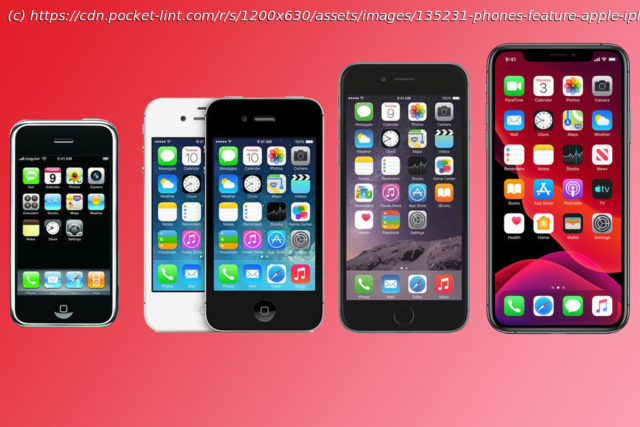It’s been over a decade since the first Apple iPhone. Yes, really. Here’s how the iPhone has evolved over its life.
Why you can trust Pocket-lint (Pocket-lint) – It’s been over a decade since the first Apple iPhone. Yes, really. The Apple iPhone first went on sale on 29 June 2007, some five months after it was originally announced on 9 January 2007. The company’s then-CEO, Steve Jobs, presented the new smartphone to a packed audience, including Pocket-lint: « This is the day I’ve been waiting for the last two years, » he said during the keynote speech at MacWorld 2007, before making the first call on the phone to Jony Ive. History of the iPhone Hard to imagine now, but the first iteration of the iPhone didn’t have a number of features we take for granted today, like copy and paste,3G and definitely not 5G, or even apps. Heck, you could also only sync it via iTunes on the desktop. Since 2007, Apple has adapted and changed the design of the iPhone a number of times, ditching the metal design for a plastic one with the iPhone 3G and 3GS, before moving to glass for the iPhone 4. It was back to metal with the iPhone 5, before glass made its comeback for the iPhone 8 models, iPhone X and the iPhone XS models. In 2020 we now have iPhones with 5G, upgraded cameras and much more besides. These 3 cases will keep your iPhone 13 slim, protected, and looking fantastic By Pocket-lint International Promotion · 9 January 2022 The iPhone hasn’t escaped criticism over the years – there’s was « bendgate », « antennagate », and even a claim by some that their beard got trapped in the casing, but it’s still a great success story. Here’s how the iPhone has evolved over its life. Apple Original Apple iPhone (2007) A 3.5-inch screen with 480 × 320 resolution for 163ppi and a 412MHz ARM processor. This was where it all started for the iPhone. In many ways it wasn’t the first, but it was certainly the most important smartphone launch. Pocket-lint verdict summary at the time: So, would we sign up for a 2-year contact? It’s a tough one. The iPhone is a great handset, however it’s also a handset that comes with multiple downsides. We are going to give it top marks, but before you sign up, you must make sure you are aware of its many limitations. Read the full Apple iPhone review Apple iPhone 3G (2008) Largely identical to the original iPhone, but with slimmer metallic outer edging and the addition of 3G connectivity. Also note the appearance of the App Store icon. The shift to centralised app stores changed the way we used our phones. Pocket-lint verdict summary at the time: Love it or hate it, there is no denying that Apple has raised the bar on the interface front. It might not be the tech spec king compared to the likes of the HTC Diamond, but from a usability point of view for the consumer, it is hard to beat. As for that BlackBerry user looking to transfer, you’ll miss search, you’ll miss « read all » and you’ll miss cut and paste. Despite the downbeat tune, it is a thumbs up from us, but if you’ve got an old iPhone and aren’t fussed about 3G or GPS, the iPhone 2.0 software update will mean the « buzz » phone of the moment is all but virtually in your pocket already. Read the full Apple iPhone 3G review Apple iPhone 3GS (2009) Similar to the 3G in design but with a faster 600MHz ARM A8 CPU, double the RAM at 256GB, and fingerprint-resistant screen coating. This was about refining the experience to bring speed, with the addition of things like a digital compass and video capture. Pocket-lint verdict summary at the time: There are so many things that work well here, making the iPhone 3GS a pleasure to use: text entry is fast and responsive; the new MMS features bring it up to date; email, calendars, and contacts are all well handled; browsing is good and fast; and the screen is sharp and bright (but not the best around). The new features like the compass and voice control make it just a little easier to use. It may offer one of the best experiences that mobile telephony has to offer, but there is still room for improvement, meaning we can all look forward to future updates with that same palpable sense of excitement. Read the full Apple iPhone 3GS review Apple iPhone 4 (2010) This is where design and power really jumped up, with a 3.5-inch 960 x 480 resolution screen and the introduction of the Retina display. The flattened glass design is now rather iconic, and it introduced a front camera with FaceTime. Pocket-lint verdict summary at the time: The iPhone 4 isn’t just a new piece of hardware. It’s the next vehicle for the world of iOS 4 and the App Store. But those hardware changes are welcomed. The inclusion of a higher-spec screen is the most significant step, combined with a faster processor, meaning it can capture and playback HD content from the new 5-megapixel camera. Is the iPhone perfect? Of course not. The experience is very well managed by Apple and many love this intuitiveness. However, many will loathe the restrictions you find in place. The design, whilst it looks nice, isn’t the most comfortable phone to hold or use, and the reception problems just compound a long history of discomfort around actually making a phone call. Apple has made its play with the iPhone 4, which we expect to be its handset for the next few years. Other manufacturers will respond in kind, but gaining the strength of the Apple ecosystem is no mean feat. While there is space to improve the iPhone, you don’t necessarily feel you are missing out. What you have is a device that is an excellent multimedia platform and open to a new generation of unfolding possibilities. Read the full Apple iPhone 4 review Apple iPhone 4S (2011) Much alike to the iPhone 4, but with the addition of more speed and the introduction of Siri as the personal assistant. The iPhone 4S announced by CEO Tim Cook on 4 October 2011; Steve Jobs passed away the following day on 5 October. Pocket-lint verdict summary at the time: The iPhone 4S is every bit a smartphone, and an excellent one at that. The range of functionality that it delivers, along with the entire ecosystem that it inhabits, still make it one of the best phones on the market. Apple has done an excellent job pushing things like the App Store and incorporating features that see wider adoption, like AirPlay, its wireless streaming system, for example. The screen could be bigger; the battery life should be longer; iOS still could be improved; there is no NFC; and Flash support or options for memory expansion. But you have to decide whether these things are important to you. If they are, you now have many choices elsewhere. To us, the iPhone 4S feels as though it has responded to the competition. It’s adapted a better notifications system and new features, but in many ways, we can’t help feeling it has adopted some of the nice things about Android. For some, the concern might be that it’s adapted Android’s battery management issue, too. The iPhone 4S is likely to be exactly what some people are looking for. For others, the excitement in other smartphone quarters could well draw their eye. Read the full Apple iPhone 4S review Apple iPhone 5 (2012) Another jump for Apple, with a larger 4-inch display running 1136 x 640 resolution, bringing with it a change in aspect for the iPhone. It also introduced a new connector, Lightning. Pocket-lint verdict summary at the time: What Apple has created with the iPhone 5 is an extremely polished smartphone that oozes appeal. It’s incredibly well built, easy to use, features a beautiful screen, and comes packed with enough speed and power to service all your requirements. The hardware is just stunning. It really is impressive how much is crammed into such a tiny box. On the software front the story isn’t as cut and dried. While the hardware and design here is cutting edge, the software plays it safer than we would like. For those of you that have already left the Apple eco-system for Samsung or HTC, for example, the iPhone 5 isn’t likely to draw you back. You might marvel at the build and design, but Apple with the iPhone 5 has created a smartphone that is too safe for you: you’ll feel too mollycoddled. Instead Apple has created a phone that the millions of current iPhone users will want to upgrade to. iPhone owners will love it, enjoy all those new features, and appreciate all the hard work, design, and engineering that has gone into it. The iPhone 5 is a phone that makes you feel safe. A phone that you know exactly how to use as soon as you take it out of the box and that is perfect many. It’s a phone that, until you start craving the iPhone 6, will serve you very well indeed. Read the full Apple iPhone 5 review Apple iPhone 5C (2013) Basically the same as the iPhone 5, but with a plastic body. The iPhone 5C was all about colour and fun, with a range of cases to make contrasting designs. Pocket-lint verdict summary at the time: The iPhone 5C is a lovely phone that is solid in its performance and playful it its approach. The combination of the colourful exterior sits beautifully against the latest iOS 7 operating system and as an upgrade to the iPhone 4S, the 5C is a perfect option, and refreshes the iPhone 5 in a way that makes it a lot more fun than the iPhone 5 ever was. But there is no denying that the 5C is merely a lick of paint on a year-old device, a non-upgrade to the iPhone 5. Some will see that as regressive, treading water. Yet, somehow, that still works in today’s world. The phone’s selection of apps, camera capabilities, and no fuss approach still means that it holds its own against the HTC One Mini devices of this world, for the right users. This is a phone that is designed to appeal to the iPhone 4S crowd who can’t afford an iPhone 5S and who don’t want to go to a different brand. The iPhone 5C is not a flagship product – Apple’s iPhone 5S is for that – nor does it fix any of the annoying niggles you’ve perhaps started to feel with your current iPhone, but if want to stick with Apple, but can’t justify the 5S and its price, then this colourful option if for you. Despite initial reservations we love the iPhone 5C – it’s colourful, joyful, capable and just works. Read the full Apple iPhone 5C review Apple iPhone 5S (2013) Sticking to the design of the iPhone 5, the iPhone 5S dropped the home button and introduced Touch ID, providing a way to unlock the phone and authenticate purchases from the App Store. Pocket-lint verdict summary at the time: The iPhone 5S fulfils the pre-determined destiny of all Apple « S » devices – it’s the one that’s normally met by the baying crowd as « meh ». But the more we’ve played with it, the more we’ve used it, and the more it’s clear that Apple has made vast improvements here. In many ways Apple has released a phone for tomorrow. That’s a hard sell, but it’s also the exciting part. The Touch ID scanner is yet to be fully realised, as are the A7 and M7 processors and the 64-bit support. But the potential for that power is huge – it’s got more grunt than its near competitors and that makes it extra exciting. We do still have a shopping list of wants though. For one, we would like a bigger and higher resolution screen. There is still no NFC and the software, despite looking cleaner, doesn’t really move the 5S on too far from where the iPhone 5 was. If you want a phone that just works, then the iPhone 5S is a very good place to start however. Apple has made it look effortless which is no simple task, and in doing so – by making it look almost too easy – you can sometimes miss the beauty and power in your hand. It’s stunning to use, there’s stacks of power, it’s without gimmicks and a nod to the future. It’s these simple elements that make the iPhone 5S, for us, one of the best phones on the market.






